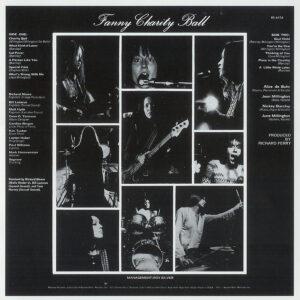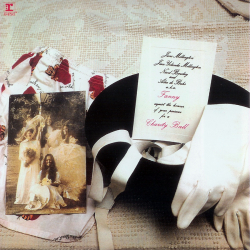In the Fall of 1971, the album and song “Charity Ball” came blasting threw AM radios across the country. At the same time, Fanny made their famed appearance on the first season of the Sonny & Cher Show. A little trivia for you: the album cover portrait of Fanny was taken by Candice Bergen of “Murphy Brown” fame.
This album put Fanny into the spotlight and started making believers out of some fans that women could rock. The single “Charity Ball” charted at #40 on Billboard’s Hot 100, but charted at the #9 position for two weeks on the WLS-AM’s Hit Parade Top 40 chart for Chicago, Illinois and even reached the #4 position on some stations in New York state. The album would hold the 150th spot on the album charts for 7 weeks in late 1971. The album showed growth not only for the group but for producer Richard Perry as he changed his approach in recording the band.
Charity Ball
Released: July 1971
Reprise RS6456
Producer: Richard Perry
Charity Ball (June Millington, Jean Millington, Alice de Buhr)
Fanny’s second album blasts off with the title track and major hit single! An infectious shuffle plays home to some Beatle-esque ‘Oohs!’, some real rock ‘n’ roll piano and a barrel-full of energy.
What Kind of Lover (Nickey Barclay)
This album contains some of Nickey’s most consistent writing and this track is a good starting point. Funky and playful, it cries out for some inventive playing from the band and boy does it get it. Everybody contributes and demonstrates a real musical progression since the debut album.
Cat Fever (Nickey Barclay)
Another consummate rocker from Nickey which powers along under the auspices of Alice’s machine gun drumming, Nickey’s own rocking piano and Jean’s riffing bass. There is some real excitement generated here which sounds more like a live take than a studio track.
A Person Like You (Nickey Barclay)
A bit of a Nickey specialty this one. It’s a sort of a funky ballad underpinned by some military drumming from Alice and containing some Elton John style piano from Nickey. A gliding slide guitar solo from June adds the cherry to the cake.
Special Care (Stephen Stills)
Fanny takes Buffalo Springfield’s rather tame version of this song and tramples all over it. Jean’s bass holds the stop-start rhythm together and she provides one of her characteristically gritty vocals. June’s minimalist solo and a thrilling instrumental jam at the play out complete this satisfying cover.
What’s Wrong With Me? (Jean Millington)
A short, delicate acoustic song from Jean showing off some inventive harmony singing in the chorus.
Soul Child (Nickey Barclay, June Millington, Jean Millington)
The atypical writing partnership of Millington, Millington and Barclay produces a rather bleak tale of life off the rails against a hard rocking backdrop. Inventive organ work from Nickey and more expert rhythm from June add to the taut atmosphere hinted at in the lyric.
You’re the One (June Millington, Jean Millington)
This moderate rocker exhibits an unusual melody built around Jean’s loping bass riff and Alice’s rock solid drumming. As always, great ensemble playing building the song to one of June’s maximum distort solos.
Thinking of You (June Millington)
One of June’s most reflective and accomplished ballads full of plaintive major 7th chords and her own yearning vocal building to a fulfilling climax in the middle section and culminating with a well constructed solo. The lull before the storm going into…
Place in the Country (Nickey Barclay)
The album’s killer track – a must for any anthology. Built very simply around a two-chord harmony, this is a wonderful bluesey romp features some mega bass runs from Jean and master class rhythm playing from June. Edgy lyrics complete the slightly tense feeling to this track, which just bubbles with energy.
A Little While Later (Nickey Barclay)
The album ends with the sort of rock ballad that The Who excelled at. Nickey’s rhythmically complex song starts out simply but then just builds and builds to a mesmerizing climax capped by June’s howling solo and then cuts to a deceptively simple harpsichord play out.


